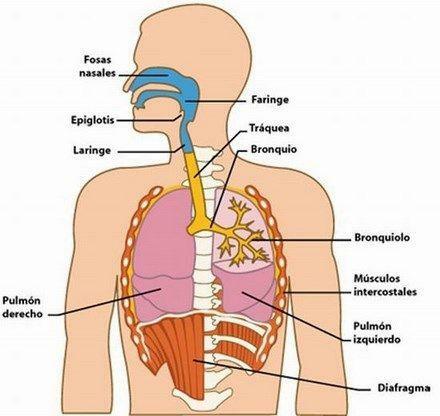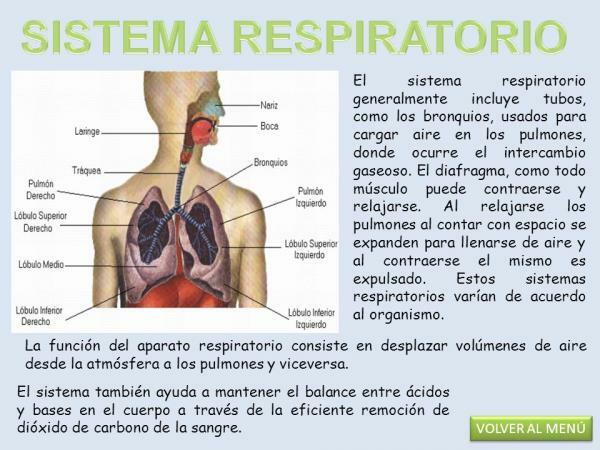Parts and functions of the respiratory system

Image: Natural Sciences
The respiratory system It fulfills a fundamental function for the human organism, which is the constant supply of oxygen to its cells and the expulsion of carbon dioxide. The lungs are the main organ of the respiratory system, with the alveolus as a functional unit. In this lesson from unPROFESOR.com we are going to study the parts and functions of the respiratory system to know the basic concepts that govern a natural and involuntary process, basic for human life, such as breathing.
By studying the parts and functions of the respiratory system we can discover how the entire process of respiration is carried out.
The respiratory system has Two parts fundamental: aerial tubes and the rib cage and lungs and the bronchial tree.
The air tubes, one of the parts of the respiratory system
Within the aerial tubes and the rib cage we can distinguish:
- Nostrils: Both cavities have the same shape and are separated by a septum of bone and cartilage. They are located above the oral cavity and are the air reception and outlet area.
- Pharynx: It is a muscular tube of about 14 cm in length that communicates from bottom to top with the ear middle, mouth, larynx and esophagus, and directing air into the trachea by contraction muscular.
- Larynx: It is located in the middle of the neck, in front of the pharynx, following the trachea below it. It is about 4 cm long and is the organ in charge of phonation.
- Windpipe: As we have pointed out, it follows the larynx and is located anterior to the esophagus. It is constituted by a series of vertical cartilaginous rings in the form of a "c", covered by tissue. In the incomplete area there is a muscle responsible for the food to pass without problems.
The lungs and bronchial tree
The lungs and the bronchial tree form the fundamental structure of the respiratory system.
- The lungs are organs located in the rib cage and essential in the respiratory system. They are surrounded by a thin membrane called the pleura, which is divided into two: visceral pleura, attached to the lungs, and parietal pleura, next to the thoracic cavity. Between these membranes there is a small space with a small amount of fluid called the pleural cavity.
- The bronchial tree It is made up of bronchi, bronchioles and alveoli, its main function being to bring air into the lungs. The trachea divides at the carina into two ducts, giving rise to the bronchi. These branch out, generating two bronchi in the left lung and three in the right.
In turn, the bronchi have small branches called bronchioles, that end in alveoli. Through the capillaries of the alveoli, hematosis or oxygenation of the blood occurs.

Image: Slideplayer
The human respiration is based on the oxygenation of the blood in the lungs, the use of oxygen and the production of carbon dioxide in the tissues, in turn removing carbon dioxide from the blood in the tissues lungs.
Air enters the respiratory system through the nose or mouth, through the windpipe. This branches into the lungs through small tubes called bronchioles, and penetrates the alveoli, where the close contact between blood and gases results in these being exchanged easily. On the other hand, the carbon dioxide carried by the blood, which is produced by the waste of cells, reaches the lungs and is expelled.
This process occurs as a result of the muscle contraction. As I breathe in -inspiration- Two sets of muscles contract: the diaphragm, which separates the chest from the abdomen, and the intercostal muscles, which are located in the ribs.
The volume of the chest increases with the contraction of these muscles, whereby the lungs expand and air enters. After contraction of the muscles, they passively relax and the lungs deflate, causing air to escape. -expiration-.
Now that you know the parts and functions of the respiratory system, we are going to discover more specifically what its internal functioning is like. As we have already explained, this respiratory system is made up of the lungs and airways; Thanks to these routes, the air we breathe through the nose reaches our lungs and, in this organ, it is where the exchange of gases takes place.
It is important to differentiate the upper from the lower pathway since the former is formed by the cavity that goes from the nose and mouth while the second is formed by the trachea, bronchi and the bronchioles. All these elements are pathways that allow the respiratory system to function optimally in our body.
Mainly, the function of this system is to allow us to breathe, that is, the oxygen that is in the air to reach our blood and CO2 is removed from the air to be able to take better advantage of oxygen. This exchange takes place within the lungs and it is an automatic and essential process in order to live.
To better understand how the respiratory system works, it is important that you take into account this steps:
- The air from outside enters our body through the nose or mouth
- Travels through the lower respiratory tract to the lungs
- In the lungs is where gas exchange occurs, that is, CO2 is removed from oxygen
- The resulting oxygen is transported by all the cells that need it to be able to survive and function fully.
Breathing is a automatic and involuntary process that we are repeating unconsciously throughout the day. It has two essential stages: inspiration, that is, when the air enters the body, and expiration, which is the moment when we expel the air to the outside.
With this procedure what our body does is take advantage of the oxygen in our environment and transfer it to the cells of our body through the bloodstream. When we exhale what we do is eliminate carbon dioxide from the body since we do not need it.
